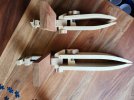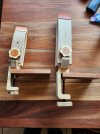RayseM
Platinum Member
- Joined
- Feb 18, 2010
- Messages
- 8,050
Hi All - I intend to build myself a stitching pony this week. The sheath making rabbit hole is meandering into the depths. 
SO - I ask a few questions of those of you who use these so that I might get this right minus a bunch of trial end error. Thanks for your thoughts.
1) Do you prefer a bench clamp model or one that you can sit on or brace with your body in some way?
2) Are multiple articulations better than a simple stand up model? I do not intend this for other than sheaths.
3) Size of jaws? 3" wide plenty or is bigger - say 5" or 6" more useful?
4) I'm guessing if you use a bench top model the overall height is relative to your seating position and your body height? Mine will be relatively short.
5) Is a quick release set up gimmicky if you have a good turn knob for easily opening and closing the jaws?
What more to ask? I don't know. Any advice or elaborations from you will be appreciated.
Thanks much.
SO - I ask a few questions of those of you who use these so that I might get this right minus a bunch of trial end error. Thanks for your thoughts.
1) Do you prefer a bench clamp model or one that you can sit on or brace with your body in some way?
2) Are multiple articulations better than a simple stand up model? I do not intend this for other than sheaths.
3) Size of jaws? 3" wide plenty or is bigger - say 5" or 6" more useful?
4) I'm guessing if you use a bench top model the overall height is relative to your seating position and your body height? Mine will be relatively short.
5) Is a quick release set up gimmicky if you have a good turn knob for easily opening and closing the jaws?
What more to ask? I don't know. Any advice or elaborations from you will be appreciated.
Thanks much.



